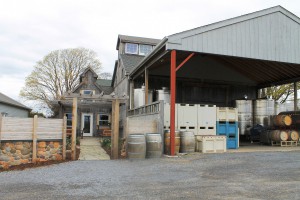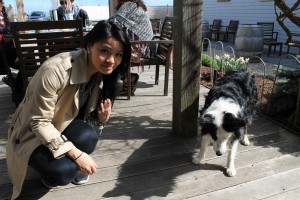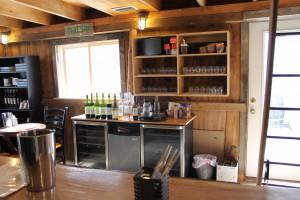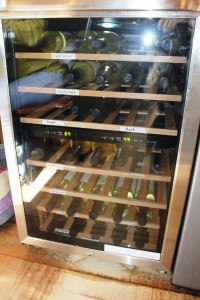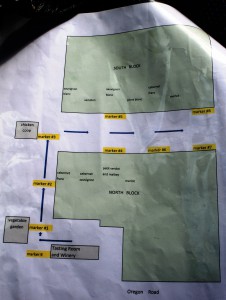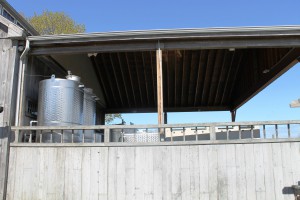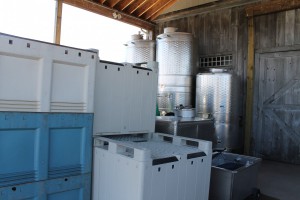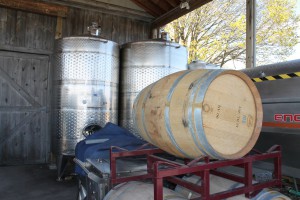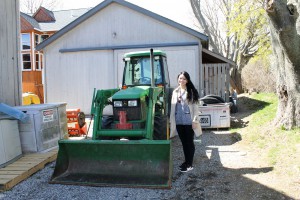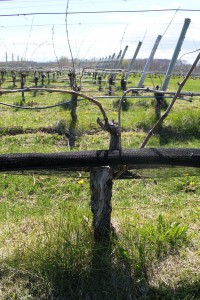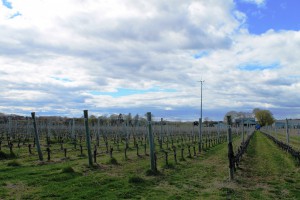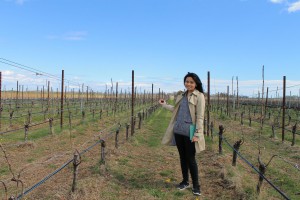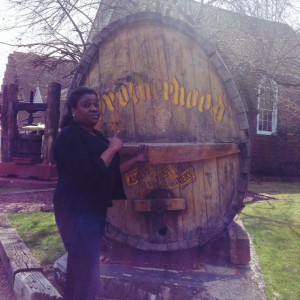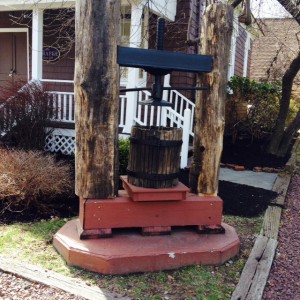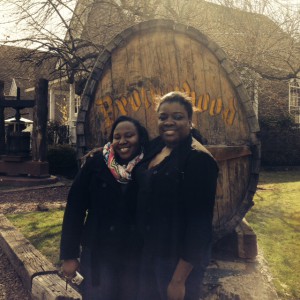We are fortunate that Rizk Zouad provided a Sake tasting in class today. There is so much to be learned. Take a look at this video her recommends.
Category Archives: Uncategorized
Hopless Beer
Gruit (alternately grut or gruyt) is an old-fashionedherb mixture used for bittering and flavoring beer, popular before the extensive use of hops. Gruit or grut ale may also refer to the beverage produced using gruit.
Gruit was a combination of herbs, commonly including sweet gale (Myrica gale), mugwort (Artemisia vulgaris), yarrow (Achillea millefolium), ground ivy (Glechoma hederacea), horehound (Marrubium vulgare), and heather (Calluna vulgaris). Gruit varied somewhat, each gruit producer including different herbs to produce unique flavors and effects. Other adjunct herbs included black henbane, juniper berries, ginger, caraway seed,aniseed, nutmeg, cinnamon, and even hops in variable proportions. Some gruit ingredients are now known to have preservative qualities.
My First Love
When faced with the decision as which winery to visit, Brotherhood was the easiest choice. Brotherhood, touted as the oldest American oldest Winery which was established in 1839. Brotherhood is located in the Hudson Valley AVA and is just a hour and a half ride outside of New York City.
On the day that I visited Brotherhood, I went with a friend. It was a beautiful spring day when we embarked on our journey which started at Port Authority in Manhattan where we took a bus to the Town of Monroe where we then took a cab to Washingtonville where the winery is located.
On arrival at the winery, it was peaceful and tranquil. We were wondering around the winery in search of the main office so that we could get some information on where we should go. We were aimlessly walking until we finally found someone who worked there and pointed us in the right direction.
As soon as we entered the main office, someone greeted us and asked if we needed help. We informed her that we were indeed in need of help and asked her where we could participate in a tour of the winery. She helped us with the purchasing of our tickets for the tour of the winery as well as for the tasting. A few minutes later, the tour was underway.
The tour was led by an elderly employee named Franklyn, who said that he was the longest serving employee. As soon as he began speaking, one could tell that he was extremely passionate about his job. He was knowledgeable about the various buildings on the property. He knew about the history behind every faucet and was knowledgeable about the wine as well he was truly happy to share it with us.
At the beginning of the tour of the cellar, one of the first questions I asked was “Are the grapes used in your wines grown on the property?” to this he replied no, the only vines are there for cosmetic purposes only. The grapes used are sourced from vineyard all over New York. So I asked how do you remain competitive? He explained that Wineries from all over the United States transport their finished wine in large containers to Brotherhood to be bottled on their behalf. This arrangement suits both parties as the other wineries save on shipping costs which providing Brotherhood with added revenue. Last year, Brotherhood bottled approximately 4 million bottles. They are projecting to double that amount this year.
When we finally descended the cellar, it was as I expected, dank, dark, and cold and the air was ripe with mildew. The fixtures appear to be old, which added to the charm of the exhibits. Along the walls were pictures and plaques that dated from the beginning of the winery. On display was several equipment that were used in the bottling of the wines over the decades. The tour continued deeper into the cellar where Giant oak barrels are kept.
These barrels are well over seven feet tall and were built in the cellar. These barrels are unique in their design as they are not held together by glue, but by the stem of a plant. This plant prevents the liquid in the barrels from leaking out. These barrels are no longer used in the production of wine, but are left so that it can be a reminder of where the winery was coming from.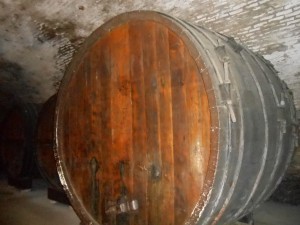
The next part of the tour is where they stored their sparkling wines. I immediately was aware of the various steps taking place in front of me. Directly in front of me was the riddling stand. Marcia and I clearly understood what was going on and confidently answered the questions he was throwing out. What stood out most to me was the thick coat of mildew on the bottles. He assured us that these bottles are well cleaned before they are labeled and sold.
The last section of the tour took us to where the wines are being aged. At this point in the tour, Franklyn informed us about the many accolades that their various wines has attained over the years. Most notable is their Riesling which is the only wine that they produce that is on the White House’s wine list.
After we left the cellar, we started on out wine tasting, we had a choice between Traditional wines or New World wines, Marcia and I both decided to try the Traditional wines. The tasting started off with a great sparkling wine called Carpe Diem. This wine was had a lot of residual sugar, which I really love, it was fruit forward with hints of peaches and apricot. The flavors lingered after I finished drinking it.
The rest of the wines we tasted were specialty wines , although they were good wines, in my estimation, they did not quite match up with the first wine Carpe Diem. The next wine we tasted was called Sweet Lolly. Just as the name implies, it was sweet. Its nose was strong with grapes, it was almost over powering. The next wine was the May Wine. This was had a rose appearance and had a nose of strawberries.
The last two wines were all red wines. The first was Rosario this was a nice red wine with a lot of residual sugar. And the last was Ruby Port it was a really a great wine and was a great way to end the tasting.
After the tasting ended I started looking around the store. I came across the Riesling in their famous Cobalt blue bottle. I was immediately taken back to my fist glass of wine that I enjoyed. At the time that I tried it, I did not know who produced it, but I knew it was a Riesling in a blue bottle. I was so excited that I found my first love. I felt accomplished and a feeling of coming full circle.

Riesling
Bedell Cellars vineyard visit
For the health conscious…
My two favorites are making me healthier!
http://www.npr.org/blogs/thesalt/2014/05/13/311904587/resveratrol-may-not-be-the-elixir-in-red-wine-and-chocolate?utm_source=tumblr.com&utm_medium=social&utm_campaign=npr&utm_term=nprnews&utm_content=20140513
Brotherhood Winery Visit
BROTHERHOOD WINERY HISTORY
Brotherhood winery has a very rich history of wine production which encompasses the history of wine production in America and about four eras of ownership. The history dates back to 1810 when Jean Jacques a French Huguenot bought land in Hudson Valley and planted grapes. Mr. Jacques original intent and interest was to be a farmer, and he raised money to buy his first land by working as a shoes and boot maker. In 1839 his first vintage wine was fermented in underground cellars that were dug then and they are still in use today. Mr. Jacques produced wine for almost 50 years until 1886 when he sold the winery to Emerson. ![IMG_2224[1]](https://openlab.citytech.cuny.edu/hmgt2402spring2014/files/2014/05/IMG_22241-300x224.jpg)
Emerson was a merchant vintner who bought Mr. Jaques high quality wine to blend and improve wine from The Brotherhood of new life organization. It is the Emerson family that renamed the winery Brotherhood winery after acquiring ownership a name that stands up to date.The Emerson family operated until 1921 when the prohibition began and sold the winery to Louis Farrell with its large stock of sacramental wines. ![IMG_2227[1]](https://openlab.citytech.cuny.edu/hmgt2402spring2014/files/2014/05/IMG_22271-300x224.jpg) As a condition of purchase Mr. Louis Farrell asked for exemption from the government to continue production of altar wine. It is this exemption that enabled the Brotherhood winery to survive the prohibition and continue grape growing and wine production when wineries across America were closed down and vineyards uprooted. During the prohibition which I learnt is called “the coming of the drought” by wine makers the number of clergy in Washingtonville greatly increased as the winery was legally allowed to produce and sell altar wine.. The Farrell family are credited in introducing the concept of tours to wineries when they realized the great potential of the winery proximity to New York and its unique underground dugout cellars, and started organizing tours of wine tasting, and the winery. Mr Cesar Baeza from Chile is the current owner with partnership of two wine making families, Castro and Chadwick having bought the winery from 1987.
As a condition of purchase Mr. Louis Farrell asked for exemption from the government to continue production of altar wine. It is this exemption that enabled the Brotherhood winery to survive the prohibition and continue grape growing and wine production when wineries across America were closed down and vineyards uprooted. During the prohibition which I learnt is called “the coming of the drought” by wine makers the number of clergy in Washingtonville greatly increased as the winery was legally allowed to produce and sell altar wine.. The Farrell family are credited in introducing the concept of tours to wineries when they realized the great potential of the winery proximity to New York and its unique underground dugout cellars, and started organizing tours of wine tasting, and the winery. Mr Cesar Baeza from Chile is the current owner with partnership of two wine making families, Castro and Chadwick having bought the winery from 1987.
The Chapel. ![IMG_2220[1]](https://openlab.citytech.cuny.edu/hmgt2402spring2014/files/2014/05/IMG_22201-300x224.jpg)
![IMG_2218[1]](https://openlab.citytech.cuny.edu/hmgt2402spring2014/files/2014/05/IMG_22181-300x224.jpg) The Presbyterian Chapel has an interesting part in the history of Brotherhood winery because it was one of the main buyer of wine between the year 1859 -1887 when the market prices fell and Mr Jacques opted to concentrate on Altar wines rather than close down.
The Presbyterian Chapel has an interesting part in the history of Brotherhood winery because it was one of the main buyer of wine between the year 1859 -1887 when the market prices fell and Mr Jacques opted to concentrate on Altar wines rather than close down. ![IMG_2229[1]](https://openlab.citytech.cuny.edu/hmgt2402spring2014/files/2014/05/IMG_22291-300x224.jpg)
GRAPES AND VINEYARD ![IMG_2257[1]](https://openlab.citytech.cuny.edu/hmgt2402spring2014/files/2014/05/IMG_22571-300x224.jpg)
![IMG_2254[1]](https://openlab.citytech.cuny.edu/hmgt2402spring2014/files/2014/05/IMG_22541-300x224.jpg) The winery doesn’t have any vineyard on the property except a few lines of the varieties(Robrusca, Concord, Chardonnay, Niagra and Cabernet blanc) they grow in their eighty hectares of land in Catskill/Hudson valley. And a few lines of a new clone they are developing with an agricultural institute. Most of the grapes used are bought in North folk, Finger Lakes and Long Island, I.e. Pinot noir, Chardonnay, Merlot and Cabernet Sauvignon. Budding of the vines starts in June and harvest takes place in September, latest early October.
The winery doesn’t have any vineyard on the property except a few lines of the varieties(Robrusca, Concord, Chardonnay, Niagra and Cabernet blanc) they grow in their eighty hectares of land in Catskill/Hudson valley. And a few lines of a new clone they are developing with an agricultural institute. Most of the grapes used are bought in North folk, Finger Lakes and Long Island, I.e. Pinot noir, Chardonnay, Merlot and Cabernet Sauvignon. Budding of the vines starts in June and harvest takes place in September, latest early October.
FERMENTATION AND STORAGE.
The winery uses stainless steel and oak barrels. Huge casks that can hold up to 700 gallons of wine are no longer in use, they now use small barrels that hold 50 gallons. They use both French Oak and American Oak. French oak is used for the soft flavors like vanilla, fruity and toasted almonds, whereas American oak is for the heavier flavor like chocolate and tobacco. White wines are made in the stainless steel because it doesn’t change flavors and makes the wine crispy. Wine is tasted once a fortnight as it ages until the winemaker obtains the flavors desired. How light or heavy the barrels are charred, the length of time, transfer from one barrel to the other and yeast contributes to flavors. Below are the underground cellars starting with the casks and the current barrels in use barrels in use.
Brut Champagne in riddling palettes going through the process of Methode Champenoise.
BOTTLING.
Bottling is done in the winery and they use three different types of caps. They use the traditional cork which is associated with premium and expensive wines by most people, and synthetic corks.The third type of cork is screw cap to which some people associate with cheap wines. The winery also does bottling for other small wineries or individual people. They also offer individual or custom made bottling, corking and labeling for special events and social occasions like graduations and weddings.
SALES.
The winery makes and sells thirty two different kinds of wines. Most of the consumers are in the state of New York, New Jersey and Connecticut. They sell online and ship to all states in America except in States prohibited by law. It was interesting to learn that there are states that legislate against their sale of wine; there weren’t more details offered as to why. Among the traditional wines they make is NY Red, NY rose, NY White. In Specialty wines they have, May Wine, Rosario, Holiday, Sweet Lolly Red, Sweet Lolly White, Carroll’s Mead and Sheba Te’j. In Dessert wines is Ruby and Cream Sherry. The premium red wines are Pinot Noir, Merlot, and Cabernet Sauvignon. Premium White Varietals are Chardonnay, Riesling, Dry Riesling and white Zinfandel. The Sparkling wines are “B” Sparkling, Blanc de Blancs, Carpe diem, Grand Mornaque, NY Sparkling and Saphir Rose. Below are the wines available for sale and their prices. Riesling is the top selling wine followed by Pinot Noir, Carpe Diem and Blanc de Blanc. ![IMG_2253[1]](https://openlab.citytech.cuny.edu/hmgt2402spring2014/files/2014/05/IMG_22531-300x224.jpg)
![IMG_2252[1]](https://openlab.citytech.cuny.edu/hmgt2402spring2014/files/2014/05/IMG_22521-300x224.jpg)
![IMG_2251[1]](https://openlab.citytech.cuny.edu/hmgt2402spring2014/files/2014/05/IMG_22511-300x224.jpg)
![IMG_2250[1]](https://openlab.citytech.cuny.edu/hmgt2402spring2014/files/2014/05/IMG_22501-300x224.jpg)
TASTING.
The winery offers tasting at a fee of $5.00 dollars and $10 dollars for tour, tasting and a souvenir glass of wine. There are 10 wines available for tasting but one choses five out of the ten. I chose Riesling, Pinot Noir, Blanc de Blancs, Sweet Lolly White and Ruby Port. I liked the Blanc de Blanc which pair well with cheeses and as an appetizer. made from 100% chardonnay it was crisp and fruity. Though port had a higher alcohol content, I liked the balance between the sweet and alcoholic taste. Sweet Lolly White was spicy and had a long finish, it pairs well with spicy food, Indian, Mexican and Sushi. Sweet Lolly White was a favorite of President Clinton administration after it won a during a contest at the White House. Pinot Noir was tannic and oaky and was recommended for anything especially when one is unsure of which wine to pair with.
TRENDS.
According to Ms. Janet who was our tour guide there is more inclination to sweeter wines rather than the tannic and strong flavors. On the global wine market USA is the leading consumer of wine from 2011, but she observed that China is quickly catching up.
It was an eye opening and educative tour that left me curious and interested in more knowledge in viticulture and oenology. Ms. Janet and Mr. Kevin whom I interacted with most were both professional and knowledgeable in the wine industry and the operation of the Brotherhood winery.
An Unforgettable Wine Experience
Growing up in Brooklyn, NY made me almost unaware of the relaxing lifestyle New York can have. As a child beside going to New Jersey for holidays, I barely left Brooklyn. I do remember going to Long Island earlier in my years, but it was not as distinctive as this time around.
The thought of needing to drive for 2 and half hours and 5 hours including the drive back, made me anxious at first. But I am so glad I decided to go through with the plan.
After setting my mind to go to Shinn Estate Farmhouse, located on 2000 Oregon Rd, Mattituck, NY 11952, I was finally able to get my brother and sister in law to drive me there. My boyfriend was interested at the fact of going to Long Island too, so he accompanied along.
On our way to the vineyard, we passed by many other winery and vineyard. The site of all those vines and farmhouse made the drive relaxing and enjoyable. The feeling of the calm city was breathtaking and made me almost forget about my busy lifestyle back in Brooklyn.
Our GPS finally navigated us to make one last turn and we finally arrived to Shinn.
After deciding that we will have a wine tasting first, before touring around in the vineyard, we walked toward to the their tasting room. I had the most unexpected, yet warmest welcome from Panda. Panda ran out of the tasting room and down the path you see on the photo on top, to greet us. He walked around us and made sure we all knew to follow him, and there he guided us to the tasting room, making sure we didn’t get lost. He brought us into the tasting room where a lady greeted us with the friendliest smile and sat us down.
My greeting from Panda to the tasting room made me feel welcome and even part of the their family. It was definitely not expected, it’s different, but unique. Once I walked into the room, I realize most guest in the room are frequenters of Shinn, they come almost every Sunday. It’s like a big family having a gathering in the tasting room. I quickly felt like I was part of the family.
Wine tasting was $10 per person for 4 different wines, so we order tasting for the table. I wanted to order cheese, but they ran out. We order salami and crackers instead.
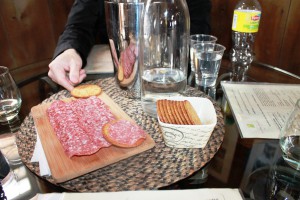 We were each given a wine list with roughly 10-15 types of wines. The wine list was separated by red and white wines, like how wine list are usually in restaurants. Our table was set similar, but not exactly the same like we do in wine class. We were each given a glass of water, but only one glass to taste the four wine, and one large bain-marie for the table as the “spit cup.”
We were each given a wine list with roughly 10-15 types of wines. The wine list was separated by red and white wines, like how wine list are usually in restaurants. Our table was set similar, but not exactly the same like we do in wine class. We were each given a glass of water, but only one glass to taste the four wine, and one large bain-marie for the table as the “spit cup.”
After seeing the wine list, we all wanted to try different wine, but we all started out with the same ones at first. Wine tasting was the highlight of my day. I went through the wine tasting with our class tasting note category in my mind. I was fortunate to lead my brother, sister in law, and my boyfriend through the wine tasting experience. My sister in law was a graduate of our Hospitality program in City Tech, and she was impressed of the words and description I used during the wine tasting.
To start off our wine tasting, clearing and getting our palate ready for the bolder wines, I picked a light cider.
Wine # 1: 2013 Wickham’s Pear Cider.
It is made from their local fruit and contains 6% alcohol. It was a correct choice to start with because the wine was light and low acid. It did not overpower the other wine I tasted after. The mouth feel was not as bubbly as I thought it would be, but it did make a light fizzing mouth feel. Pears was exactly what I tasted, but I also tasted a hint of apples. I will pair this wine with an appetizer such a zesty lime shrimp or oysters.
Wine # 2: 2013 Coalescence (Sauvignon blanc, Chardonnay, Riesling)
I choose this wine because it contain Riesling and I developed a love for Riesling through our wine tasting in class. So after tasting, I asked my my brother what he tasted.
His words was, “hmmm hmmm hmm.” My sister in law and my boyfriend laughed and said yes, it definitely tasted “hmmm hmmm hmm.”
I then explained to them, the reason why you felt that way is because of the mouth feel. The wine is tingling in your mouths and it gives you a watery mouth feel.
The wine was definitely had a refreshing taste, probably from it stainless steel, but the fruits was the main component to the wine. I tasted strong taste of apples and papayas, and a hint of honey. It pairs well with linguine and salmon drizzled with a green apple vinaigrette.
Wine #3: 2009 Nine Barrels Blend (Merlot, Petit Verdot, Malbec)
The transitioning of white wines to red wine is always interesting because of its mouth feel. After enjoying the light, airy, and refreshing mouth and suddenly tasting a wine that is bolder and full of character was difficult.
Before tasting the wine, I had a clear look of the color of the wine. It was dark red with a hint of rim variation of orange. I saw a little hint of sediment poured into the glass.
I had to split twice before I had a real sense of what the 2009 Nine Barrels Blend was. But after the third taste, my mouth suddenly was able to distinguish the taste of dark fruits notes such as cranberry, plums, and prunes. In addition, I also tasted a hint of cloves and pepper. I tasted strong oak and the tannins coated my entire mouth leaving it dry and the dryness lingered.
As for the pairing of this wine, I will definitely go with the Rib-eye steak because of its fat content. Also a lamb stew or dishes with a bit more moistness to it will be a ideal pairing for this dry- full body wine.
Wine # 4: 2013 Rosé (Merlot, Cabernet franc)
For my last wine tasting, I wanted to try something different that I never tried before. I was glad I made that decision because I started to like Rosé and I even brought a bottle home for $16.
Transitioning from 2009 Nine Barrels Blend to the Rosé, I suggested to drink some water and even rinse a bit because I knew the Rosé was lighter than the Nine Barrels, and I didn’t want it to overpower the Rosé.
The Rosé was light red and pink in color. It tingled a bit in the mouth feel and it had some dryness, but it did not linger and it did not cough the mouth. It was refreshing with strong notes of fruits, like melons, papayas, apples, and note of honey and syrup.
After tasting the Rosé, my brother bursted out the words, “Cocktail Shrimp, Sushi, Live Uni,” and there he gave me the perfect pairing for this Rosé.
During this wine tasting, I not only did myself a favor and found a wine I enjoy, but I guided the wine tasting and made my family learn more about wine because “I study wine.”
After the wine tasting, we grabbed the maps and started our tour on the vineyard. Their were no grapes on the vines yet, but we saw some spurs on its cordons. As for wine storing and aging I saw stainless steel barrels. They use machinery in their harvest. Some varieties of grapes they grow are Sauvignon Blanc, Pinot Blanc, Cabernet Franc, Semillon, Merlot, Petit Verdot, Malbec, and Canernet Sauvignon.
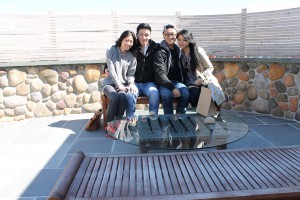 This concludes my day at Shinn, but the experience was memorable. By going to class every week, I learned all the necessary technical and basic skills of wine and wine-making, but by going to the vineyard/winery I was able to connect and relate to all the background information I learned and applied it to a real world experience. This assignment has truly made an impact to my wine studying.
This concludes my day at Shinn, but the experience was memorable. By going to class every week, I learned all the necessary technical and basic skills of wine and wine-making, but by going to the vineyard/winery I was able to connect and relate to all the background information I learned and applied it to a real world experience. This assignment has truly made an impact to my wine studying.
Australian Dessert Wines!
I recently dined at the Gramercy Tavern (42nd E 20th St) as part of my service analysis project for Dining Room Operations. Now, I know we haven’t really had a chance to explore Australian wines but I thought I should share this with my fellow wine enthusiasts.
During our final course of the spring tasting menu, our server Ana gifted us a glass of 2011 Elderton Botrytis Semillon. The front label spelled out “BOTRYTIS SEMILLON” in bold letters and instantaneously I thought of Sauternes from the Bordeaux region of France. Little did I know, I looked in to the wine list and found out that this dessert wine actually comes from the Barossa Valley of Australia.
A little bit about Barossa Valley:
It’s located 40 miles northeast of Adelaide in the state of South Australia. Barossa Valley has a long tradition of winemaking dating back to the 1840s and is one of the most important Australian wine regions. Although this region is largely known for their red grape varietals (e.g., Shiraz, Grenache, Mourvèdre a.k.a. Mataro in AU), the more cooler climates in the higher elevation allow for production of such wines as botrytised Semillon.
“A deep gold in color, offering rich and opulent aromas, this bursts with honeyed pineapples, hazelnut, and creme brûlée flavors that come together seamlessly on the long and expressive finish. Evocative of a good Sauternes.”, says Wine Spectator.
My instincts weren’t entirely wrong after all.
This wine was very delicious; about $20+ for a bottle sold in retail; more expensive if you order it by the glass at a restaurant. Regardless, I had a sensational experience at the Gramercy Tavern and I highly recommend this wine.

https://m.danmurphys.com.au/mob/product/DM_903644/elderton-botrytis-semillon-375ml.jsp;jsessionid=91576D0441B93EFE6A76AA9A7CDF4429.ncdlmorasp1306?bmUID=klJwnLB
My Journey to Upstate New York
Equipment’s that were used to make wine in the 1800s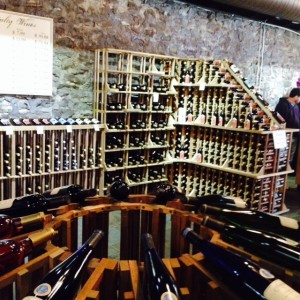

At the start of the semester when I realized that the class had to go to a winery; I was not enthusiastic about the idea. Am I happy now that it is a part of the class requirement? Yes I am. My journey took me to upstate New York (Monroe). There you find the beautiful and spacious Brotherhood Winery. The Brotherhood winery is the oldest winery in the United States of America. First opened in 1839 with about ten acres of land. However, in 1999 a devastating fire destroyed all the original buildings. The winery had since been rebuilt and is now set up-on about four acres of land, and is privately owned by Casar Baeza a wine master from Chile.
My journey from the Bronx to the winery took about three hours on the train then to a Short Line Tour bus. After reaching the winery the staff was friendly, professional, and very informative. They informed us that they offer five to six tours per day and that one was about to start in ten minutes. It was six dollars just for the tour and ten dollars for the tour and wine tasting session. As luck could have it we got the longest working employee on the property; Franklyn he seemed to know everything about the winery.
As Franklyn took us on our tour; stopping every so often to point out important facts. I realized that I knew what he was talking about why? Because I study wine with Professor Goodlad. The Brotherhood winery is one of four wineries in the New York Region. There is a small vineyard but it is not used to plant grapes for production. However, it is used to preserve important grape vines. Brotherhood winery get their grapes to make their wines from Lake Erie, Finger Lakes, Hudson, and Long Island AVA’s. The winery is known for producing great Pinot Noir, Chardonnay, Merlot, and Riesling Dry. Brotherhood winery has a bottling plant that bottles wine from wineries all over
the United States. In 2013 they bottled over four million bottles of wine and are expected to bottle eight million bottles of wine in 2014. 2013 was a great year for the Brotherhood Winery, in a wine tasting competition with some of the best wine producing wineries across America. Brotherhood winery took home gold, silver and bronze medals. The Riesling dry took the gold, Pinot Noir and Merlot took silver, and the Cabernet Sauvignon took the bronze medals.
At the end of our tour we had a wine tasting session, we tasted one Sparkling Wine Carpe Diem, 2013, three Specialty Wines Sweet Lolly Red, May Wine, and Rosario and one Dessert Wine Ruby Port. Thanks to my journey to the winery I found out that I am a sparkling wine lover. The Carpe Diem tasted first-rate and it is now the wine for me. Color: gold, Nose: fruity and sweet, Taste: peach and apricot, coats the mouth faintly. Carpe Diem would pair well with grilled chicken breast and red and green peppers with a twist of lemon. It was a wonderful experience that I got to share with my friend Nykkeicha. On the ride home I realized that I was no longer afraid of the taste of wine, and that is a wonderful thing. 

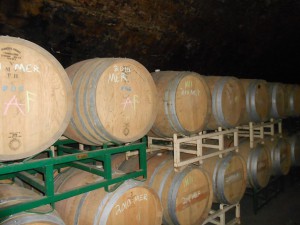
![IMG_2264[1]](https://openlab.citytech.cuny.edu/hmgt2402spring2014/files/2014/05/IMG_22641-300x224.jpg)
![IMG_2258[1]](https://openlab.citytech.cuny.edu/hmgt2402spring2014/files/2014/05/IMG_22581-300x224.jpg)
![IMG_2262[1]](https://openlab.citytech.cuny.edu/hmgt2402spring2014/files/2014/05/IMG_22621-300x224.jpg)
![IMG_2231[1]](https://openlab.citytech.cuny.edu/hmgt2402spring2014/files/2014/05/IMG_22311-300x224.jpg)
![IMG_2232[1]](https://openlab.citytech.cuny.edu/hmgt2402spring2014/files/2014/05/IMG_22321-300x224.jpg)
![IMG_2245[1]](https://openlab.citytech.cuny.edu/hmgt2402spring2014/files/2014/05/IMG_22451-300x224.jpg)
![IMG_2240[1]](https://openlab.citytech.cuny.edu/hmgt2402spring2014/files/2014/05/IMG_22401-300x224.jpg)
![IMG_2237[1]](https://openlab.citytech.cuny.edu/hmgt2402spring2014/files/2014/05/IMG_22371-300x224.jpg)
